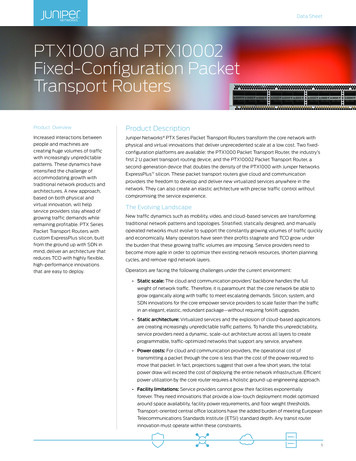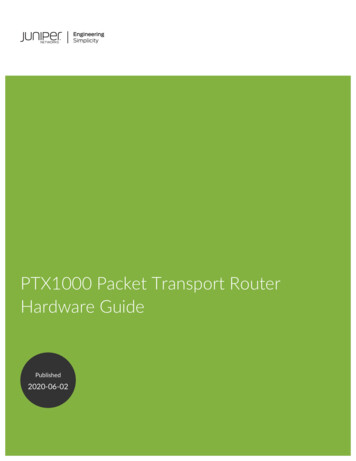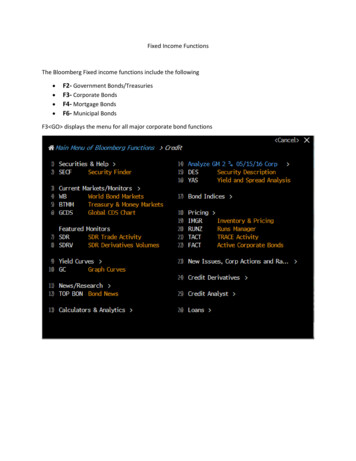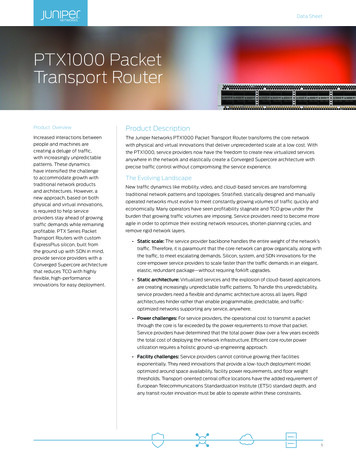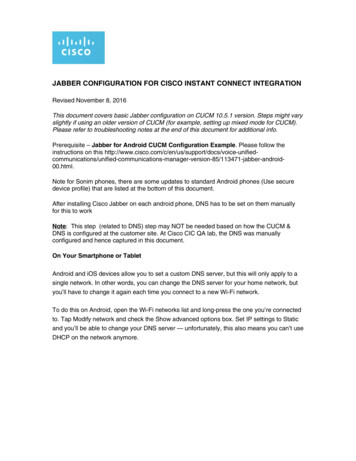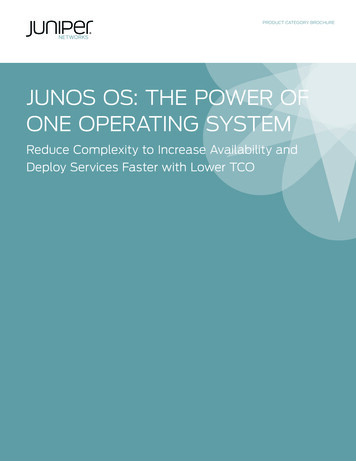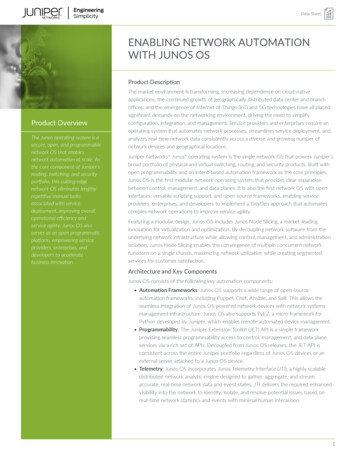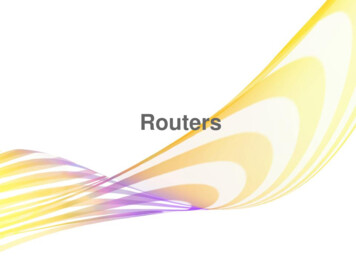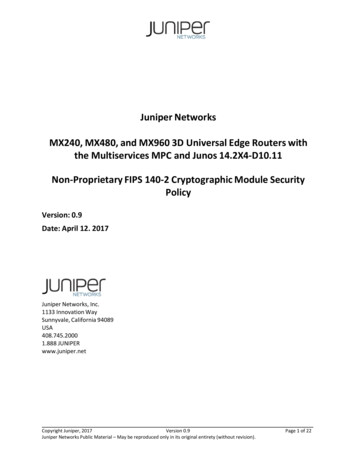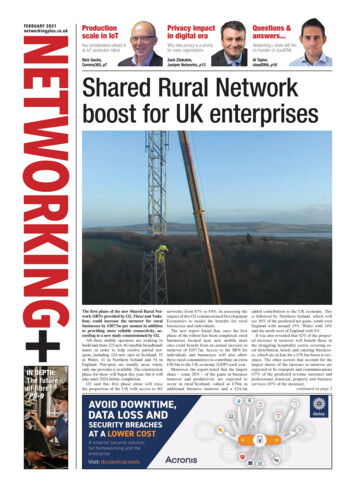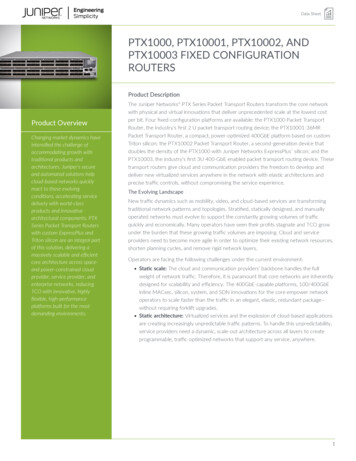
Transcription
Data SheetPTX1000, PTX10001, PTX10002, ANDPTX10003 FIXED CONFIGURATIONROUTERSProduct DescriptionProduct OverviewChanging market dynamics haveintensified the challenge ofaccommodating growth withtraditional products andarchitectures. Juniper’s secureand automated solutions helpcloud-based networks quicklyreact to these evolvingconditions, accelerating servicedelivery with world-classproducts and innovativearchitectural components. PTXSeries Packet Transport Routerswith custom ExpressPlus andTriton silicon are an integral partof this solution, delivering amassively scalable and efficientcore architecture across spaceand power-constrained cloudprovider, service provider, andenterprise networks, reducingTCO with innovative, highlyflexible, high-performanceplatforms built for the mostdemanding environments.The Juniper Networks PTX Series Packet Transport Routers transform the core networkwith physical and virtual innovations that deliver unprecedented scale at the lowest costper bit. Four fixed-configuration platforms are available: the PTX1000 Packet TransportRouter, the industry’s first 2 U packet transport routing device; the PTX10001-36MRPacket Transport Router, a compact, power-optimized 400GbE platform based on customTriton silicon; the PTX10002 Packet Transport Router, a second-generation device thatdoubles the density of the PTX1000 with Juniper Networks ExpressPlus silicon; and thePTX10003, the industry’s first 3U 400-GbE enabled packet transport routing device. Thesetransport routers give cloud and communication providers the freedom to develop anddeliver new virtualized services anywhere in the network with elastic architectures andprecise traffic controls, without compromising the service experience.The Evolving LandscapeNew traffic dynamics such as mobility, video, and cloud-based services are transformingtraditional network patterns and topologies. Stratified, statically designed, and manuallyoperated networks must evolve to support the constantly growing volumes of trafficquickly and economically. Many operators have seen their profits stagnate and TCO growunder the burden that these growing traffic volumes are imposing. Cloud and serviceproviders need to become more agile in order to optimize their existing network resources,shorten planning cycles, and remove rigid network layers.Operators are facing the following challenges under the current environment: Static scale: The cloud and communication providers’ backbone handles the fullweight of network traffic. Therefore, it is paramount that core networks are inherentlydesigned for scalability and efficiency. The 400GbE-capable platforms, 100/400GbEinline MACsec, silicon, system, and SDN innovations for the core empower networkoperators to scale faster than the traffic in an elegant, elastic, redundant package—without requiring forklift upgrades. Static architecture: Virtualized services and the explosion of cloud-based applicationsare creating increasingly unpredictable traffic patterns. To handle this unpredictability,service providers need a dynamic, scale-out architecture across all layers to createprogrammable, traffic-optimized networks that support any service, anywhere.1
PTX1000, PTX10001, PTX10002, and PTX10003 Fixed Configuration Routers Power costs: For cloud and communication providers, theoperational cost of transmitting a packet through the core isless than the cost of the power required to move that packet.In fact, projections suggest that over a few short years, thetotal power draw will exceed the cost of deploying the entirenetwork infrastructure. Efficient power utilization by the corerouter requires a holistic ground-up engineering approach. Facility limitations: Service providers cannot grow theirfacilities exponentially forever. They need innovations thatprovide a low-touch deployment model optimized aroundspace availability, facility power requirements, and floor weightthresholds. Transport-oriented central office locations have theadded burden of meeting European TelecommunicationsStandards Institute (ETSI) standard depth. Any transit routerinnovation must operate within these constraints.In order to address these challenges, cloud and communicationproviders need an innovative, scalable core router that satisfiesthree defining principles: performance, deployability, and SDNprogrammability. The PTX1000, PTX10001-36MR, PTX10002, andPTX10003 fixed-configuration packet transport routers provide thefoundation for a scale-out core backbone architecture, ensuring aconsistent user experience across geographies. The PTX1000,PTX10001-36MR, PTX10002, and PTX10003 meet all existingtraditional core requirements, easily fitting into cloud andcommunication provider networks that require transit-focused IP/MPLS applications such as Internet peering, scale-out metro andbackbone topologies, and label-switching router (LSR) optimizeddeployments.Architecture and Key ComponentsThe PTX1000, PTX10001-36MR, PTX10002, and PTX10003 fixedconfiguration packet transport routers bring physical and virtualinnovation to the cloud and service provider core networks,addressing concerns about operational expenditures while scalingorganically to keep pace with growing traffic demands with thefollowing features: Core routing: The PTX1000, PTX10001-36MR, PTX10002,and PTX10003 employ a massively scalable yet compact 1, 2,or 3 U form factor with secure connectivity and high flexibility. Peering: The PTX Series fixed platforms are perfect for scaleout peering in space- and power-constrained environmentswith full traffic visibility and L3 services. LSR: The PTX Series fixed platforms provide 2.88 Tbps to 16Tbps aggregate capacity for multi-plane core networks as anLSR router. They can also be positioned as an LSR fabric nodein spine-leaf architectures for increased scale and reducedblast radius. CDN Gateway: The compact PTX Series offers high routingscale in a 1, 2, or 3 U fixed form factor for full traffic statisticsvisibility and deep buffers. Data Center Interconnect (DCI): The PTX10001-36MR andPTX10003 offer secure inline MACsec with no compromise inthroughput or latency, and an extended range enabled by400GbE ZR / ZR .Innovations in SiliconPhysical innovations at the core silicon level enable the PTX Seriesfixed-configuration routers to reduce OpEx and accommodatescale-out architectures with smooth migration paths as trafficpatterns change.ExpressPlus and Express-Based SiliconThe PTX1000 and PTX10002 are powered by ExpressPlus silicon,delivering predictable IP/MPLS packet performance andfunctionality. The PTX10003 is powered by functionally equivalentExpressPlus Silicon to support high-density 100/200/400GbEinterfaces and inline MACsec with no performance penalty whiledelivering the same IP/MPLS functionality. ExpressPlus siliconeliminates the complex sawtooth packet profile found in elaborate,over-engineered network processing units (NPUs) deployed inother core routers. This delivers the peering scale required to matchexpanding traffic demands.These devices build upon the Juniper Networks Junos Expresssilicon concepts of low consistent latency and wire-rate packetperformance for both IP traffic and MPLS transport, withoutsacrificing the optimized system power profile. These concepts areincorporated into the PTX Series design along with full IPfunctionality, preserving the spirit of the original Junos Expresschipset. The ExpressPlus silicon is the first purpose-builttelecommunications silicon to engineer a 3D memory architectureinto the base design for more than 1.6 billion filter operations persecond, dynamic table memory allocation for mammoth IP routingscale, and enormous power efficiency gains. The PTX10003supports inline MACsec on all interfaces using 10/40/100GbE.2
PTX1000, PTX10001, PTX10002, and PTX10003 Fixed Configuration RoutersTriton SiliconThe PTX10001-36MR is powered by the highly scalable, nextgeneration ASIC in the Express silicon family, Juniper Triton silicon—the industry’s first inline MACsec for 400GbE chips that supportsuniversal multirate QSFP56-DD. Juniper Triton silicon deliversconsistently low latency, 8m counters, 256 AES MACsecencryption supported on all ports, and wire-rate packetperformance for IP traffic without sacrificing the optimized systempower profile. Preserving the spirit of the Junos Express siliconfamily, Juniper Triton silicon is the first purpose-builttelecommunications silicon to incorporate a 3D memoryarchitecture into the base design, offering the industry’s highestpacket performance per gigabit in the fewest rack units. It alsoprovides dynamic table memory allocation for massive IP routingscale while delivering tremendous power efficiency gains at 0.14Watts/Gig.The ability to address a provider’s core networking requirements—scale, operational flexibility, and SDN control—begins with thesilicon. With the PTX Series fixed-configuration routers, operatorscan now deploy a core architecture with SDN control. CombiningJuniper Networks NorthStar Controller with a robust full-featuredInternet backbone router, and a regional IP/MPLS core router withintegrated 100GbE coherent transport for superior performance,operators can tune their network infrastructure through proactivemonitoring and what-if planning capabilities. The NorthStarController dynamically creates explicit routing paths using a globalview based on user-defined constraints to create a fullyautonomous operation.Scale is one of the guiding design principles for the PTX Seriesrouters, allowing network operators to smoothly handle increasedtraffic demands. The PTX Series fixed-configuration routers simplifynetwork engineering challenges with predictable system latency,improving the overall service experience by delivering best-in-classresiliency to help providers meet strict customer service-levelagreements (SLAs).Operational efficiency is another design attribute for the PTX Seriesrouters, focusing on power, space, and weight—fundamentalconcerns that affect network operators’ operational budgets.Juniper has designed the PTX Series to fit the requirements ofcurrent and future data center facilities.SDN programmability brings virtual innovations to the serviceprovider core, while the NorthStar Controller offers an open,standards-based solution that optimizes both the IP layer and thetransport layer with precise SDN control, allowing networkoperators to fully automate and scale their operations with ease.PTX1000, PTX10002, and PTX10003 Fixed-ConfigurationPacket Transport RoutersPTX1000The PTX1000, with its rich IP/MPLS feature set, lets serviceproviders organically distribute peering points throughout thenetwork without sacrificing performance and deployability—themain contributors to eroding TCO for service providers whenpeering. The PTX1000 expands the applications scope that the PTXSeries architecture addresses, enabling service providers toimplement a distributed core architecture for interconnectinggrowing cloud services. Service providers can distribute peeringpoints to match traffic demand with an optimized core routerwithout sacrificing performance or deployability. The PTX1000 is afirst-generation fixed-configuration core router, providing up to 3million FIB and 10 million routing information base (RIB) in a 2 Ufootprint, making it easily deployable in space-constrained Internetexchange locations, remote central offices, and embedded peeringpoints anywhere in the network, including cloud-hosted services.The PTX1000 operates at 2.88 Tbps in a fixed core routerconfiguration and supports flexible interface configuration options,including 288 10GbE ports via a quad small form-factor pluggableplus transceiver (QSFP ) breakout, 72 40GbE ports via QSFP , and24 100GbE ports via QSFP28.PTX10001-36MRThe PTX10001-36MR features a compact, 1 U form factor that iseasy to deploy in space- and power-constrained Internet exchangelocations, remote central offices, and embedded peering pointsthroughout the network, including cloud- hosted services.The PTX10001-36MR is particularly suited for power-constrainedenvironments, providing unprecedented power efficiency of 0.14watts/Gbps. It offers up to 2 million FIB, deep buffers, andintegrated 100GbE and 400GbE MACsec capabilities. ThePTX10001-36MR operates at 9.6 Tbps in a fixed core routerconfiguration with 36 multi-rate ports—24 400GbE (QSFP56-DD)ports and 12 100GbE (QSFP28) ports to facilitate the migrationfrom 100GbE to 400GbE deployments.The PTX10001-36MR features flexible interface configurationoptions with universal multi-rate QSFP-DD for 100GbE/400GbE tosupport 120 10GbE ports with QSFP breakout, 60 100GbE portswith QSFP28-DD (24x2) and QSFP28 (12), 108 100GbE ports withQSFP56-DD breakout (24x4) and QSFP28 (12), and 24 400GbEports with QSFP56-DD.3
PTX1000, PTX10001, PTX10002, and PTX10003 Fixed Configuration RoutersPTX10002The PTX10002 is a second-generation PTX Series fixedconfiguration core router featuring a compact, 2 U form factor thatis easy to deploy in space-constrained Internet exchange locations,remote central offices, and embedded peering points throughoutthe network, including cloud-hosted services.The PTX10002 operates at 6 Tbps in a fixed core routerconfiguration. It supports flexible interface configuration options,offering 60 physical quad small form-factor pluggable 28 (QSFP28)100GbE ports, 60 QSFP 40GbE ports, and 192 10GbE ports viaQSFP breakout cables.PTX10003The PTX10003 is a fixed-configuration core router featuring acompact, 3 U form factor that is easy to deploy in spaceconstrained Internet exchange locations, remote central offices, andembedded peering points throughout the network, including cloudhosted services. It offers up to 4 million FIB, deep buffers, andFeatures and BenefitsPerformance is one of the guiding design principles for the PTXSeries Packet Transport Routers. This focus empowers cloud andservice providers with superior scale to match increased trafficlevels and network engineering challenges with predictable systemlatency to improve the overall service experience, deliver best-inclass resiliency, and ensure that services meet strict customer SLAs.Deployability is the other guiding design principle for the PTXSeries routers, focusing on power, space, and weight—fundamentalconcerns that impact service providers’ operational budget withrespect to growing traffic.Infinite programmability with automation and telemetry bringsvirtual innovations to the cloud and service provider core, while theNorthStar Controller is an open, standards-based solution thatoptimizes both the IP layer and the transport layer with preciseSDN control, allowing service providers to automate and scaleoperations with efficiency, simplicity, and security.integrated 100GbE MACsec capabilities.One Junos Experience delivers operational consistency anduniformity across PTX Series platforms and solutions. The mostThe PTX10003 uniquely addresses power-constrainedenvironments by providing unprecedented power efficiency of 0.2watts/Gbps. Two versions of the PTX10003 are available,supporting 8 Tbps and 16 Tbps respectively in a 3 U footprint.modern OS on the market, Junos Evolved, is designed from theground up for reliability, resiliency, velocity, and integrationsimplicity.Operating in a fixed core router configuration, the 8 Tbps modelfeatures flexible interface configuration options with universalmulti-rate QSFP-DD for 100GbE/400GbE to support 160 (QSFP )10GbE ports, 80 (QSFP28) 100GbE ports, 32 (QSFP28-DD)200GbE ports, and 16 (QSFP56-DD) 400GbE ports.Table 1 summarizes the features available on the fixedconfiguration PTX Series Packet Transport Routers.The 16 Tbps model also offers universal multi-rate QSFP-DD for100GbE/400GbE to support 320 (QSFP ) 10GbE ports, 160(QSFP28) 100GbE ports, 64 (QSFP28-DD) 200GbE ports, and 32(QSFP56-DD) 400GbE ports.4
PTX1000, PTX10001, PTX10002, and PTX10003 Fixed Configuration RoutersTable 1. Fixed-Configuration PTX Series Features and BenefitsFeatureFeature DescriptionBenefitSystem capacityThe PTX1000 scales to 3 Tbps in a single chassis, breaking out into 288 10GbE, 72 40GbE, and 24 100GbE interfaces.The PTX10001-36MR scales to 9.6 Tbps in a single chassis, featuring flexible interface configuration options withuniversal multi-rate QSFP-DD for 100GbE/400GbE to support 120 10GbE ports with QSFP breakout, 60 100GbEports with QSFP28-DD (24x2) and QSFP28 (12), 108 100GbE ports with QSFP56-DD breakout (24x4) and QSFP28(12), and 24 400GbE ports with QSFP56-DD.The PTX10002 scales to 6 Tbps in a single chassis, breaking out into 192 10GbE, 60 40GbE, and 60 100GbEinterfaces.The PTX10003 8 Tbps model scales to 8 Tbps is a single chassis, breaking out into 160 10GbE, 80 100GbE, 32200GbE, and 16 400GbE interfaces.The PTX10003 16 Tbps model scales to 16 Tbps in a single chassis, breaking out into 320 10GbE, 160 100GbE, 64200GbE, and 32 400GbE interfaces.The PTX1000, PTX10001-36MR, PTX10002, andPTX10003 give cloud and service providers theperformance and scalability needed to outpacegrowing traffic demands.High availability(HA) hardwareThe PTX1000, PTX10001-36MR, PTX10002 and PTX10003 are built with hardware redundancy for cooling, powersupplies, and forwarding.HA is critical for service providers to maintain analways-on infrastructure base and meet stringentSLAs across the core.PacketperformanceThe PTX1000 and PTX10002 include groundbreaking ExpressPlus silicon, empowering them with unparalleled packetprocessing for both full IP functionality and MPLS transport, leveraging a revolutionary 3D memory architecture. ThePTX10003 uses a newer version of ExpressPlus silicon that delivers inline MACsec on all ports and dense100/400GbE. The PTX10001-36MR uses the next generation of Express, Triton silicon, that delivers 100/400GbEinline MACsec on all ports for dense 400GbE architectures.Exceptional packet processing capabilities helpalleviate the challenge of scaling the network astraffic levels increase while optimizing IP/MPLStransit functionality around superior performanceand elegant deployability.Ultra-compact 1 U, With cutting-edge innovation in power and cooling technology, the PTX fixed-configuration core routers provide2 U and 3 U form compact, power-optimized scale and efficiency. The PTX1000 provides 2.88 Tbps of capacity in a 2 U form factor; thefactorPTX10001-36MR provides 9.6 Tbps in a 1 U form factor; the PTX10002 provides 6 Tbps of capacity in a 2 U formfactor; the PTX10003 provides up to 16 Tbps of capacity in a 3 U form factor.SecuritySpace efficiency is a critical requirement forpeering Internet exchange points, peeringcollocations, central offices, and regionalnetworks, especially in emerging markets.The PTX Series Packet Transport routers use a combination of hardware-based mechanisms like MACsec and software- Inline data plane MACsec security with nobased features like firewall filters and DDoS to provide scalable security. 100GbE and 400GbE inline MACsec isthroughput or latency penalties in addition tosupported on all ports with no compromise in latency.control plane security with DDoS.5
PTX1000, PTX10001, PTX10002, and PTX10003 Fixed Configuration RoutersPTX Series Fixed-Configuration Routers PTX10003 (8T)PTX10003 (16T)System throughput3 Tbps9.6 Tbps6 Tbps8 Tbps16 TbpsForwarding capacityUp to 2 BppsUp to 6 BppsUp to 4 BppsUp to 5.3 BppsUp to 10.6 BppsMax. 10GbE portdensity288120192160320Max. 40GbE portdensity7230604080Max. 100GbE portdensity241086080160Max 200GbE portdensity-48-3264Max 400GbE portdensity-24-1632Dimension (WxHxD)17.4 x 3.46 x 31 in(44.2 x 8.8 x 78.7 cm)17.3 x 1.75 x 25.5 in(44 x 4.45 x 64.8 cm)17.4 x 3.46 x 31 in(44.2 x 8.8 x 78.7 cm)17.4 x 5.25 x 31 in(44.2 x 13.3 x 78.7 cm)17.4 x 5.25 x 31 in(44.2 x 13.3 x 78.7 cm)Rack units2U1U2U3U3UWeight68 lb (31 kg)39.7 lb (18 kg)68 lb (31 kg)88 lb (40 kg)110 lb (50 kg)CPUIntel Quad Core Ivy Bridge 2.5 Intel Xeon 12-Core 2.1 GHz CPUGHz CPUInte
PTX1000, PTX10001, PTX10002, AND PTX10003 FIXED CONFIGURATION ROUTERS Product Description The Juniper Networks PTX Series Packet Transport Routers transform the core network with physical and virtual innovations that deliver unprecedented scale at the lowest cost per bit. Four fixed-conf
